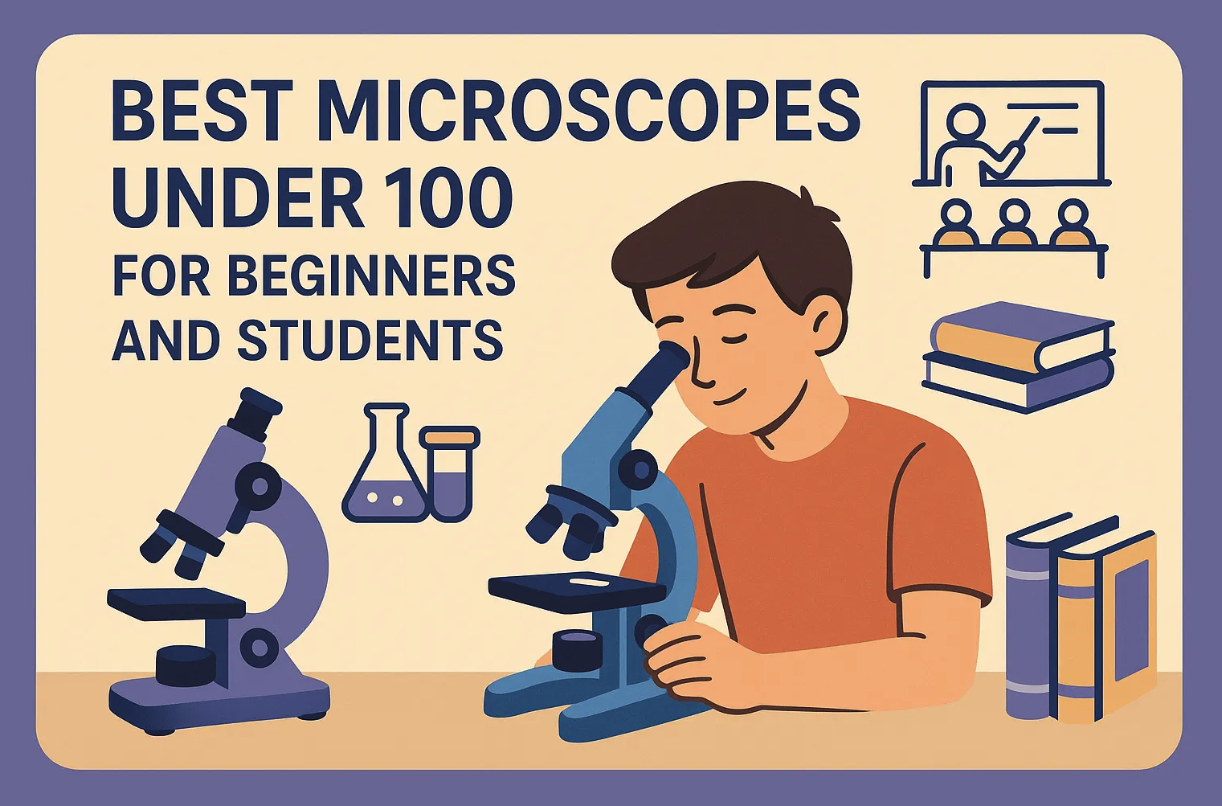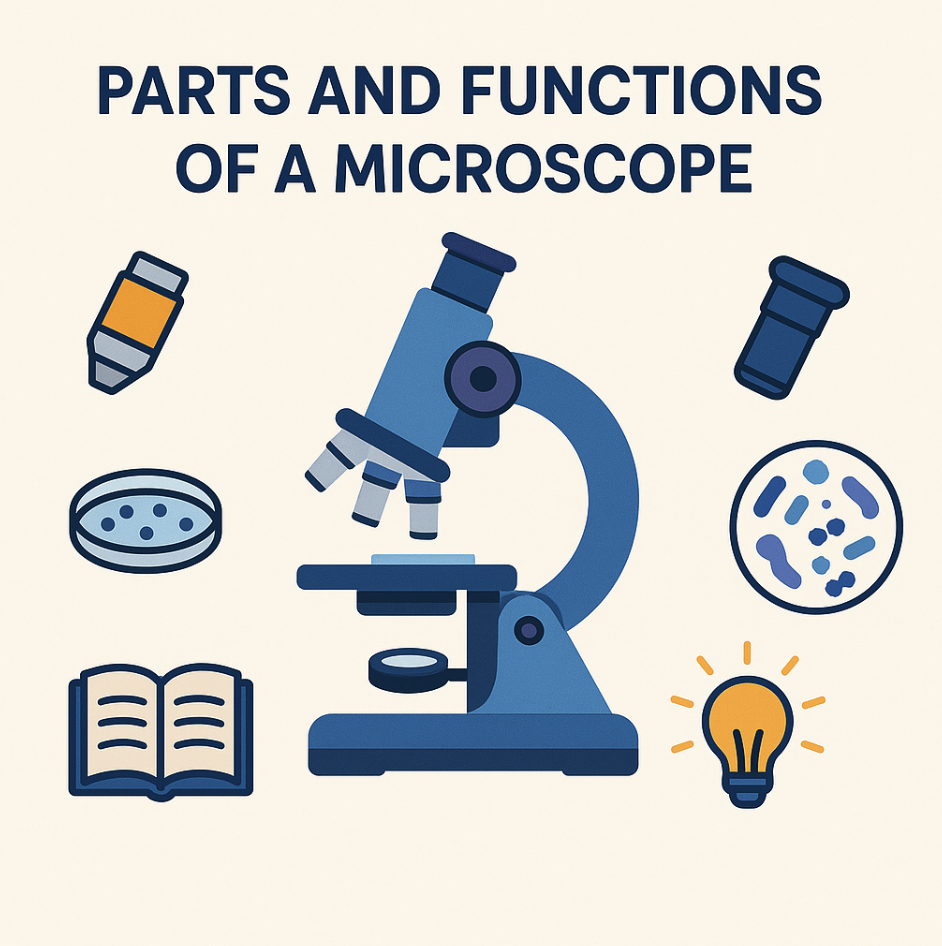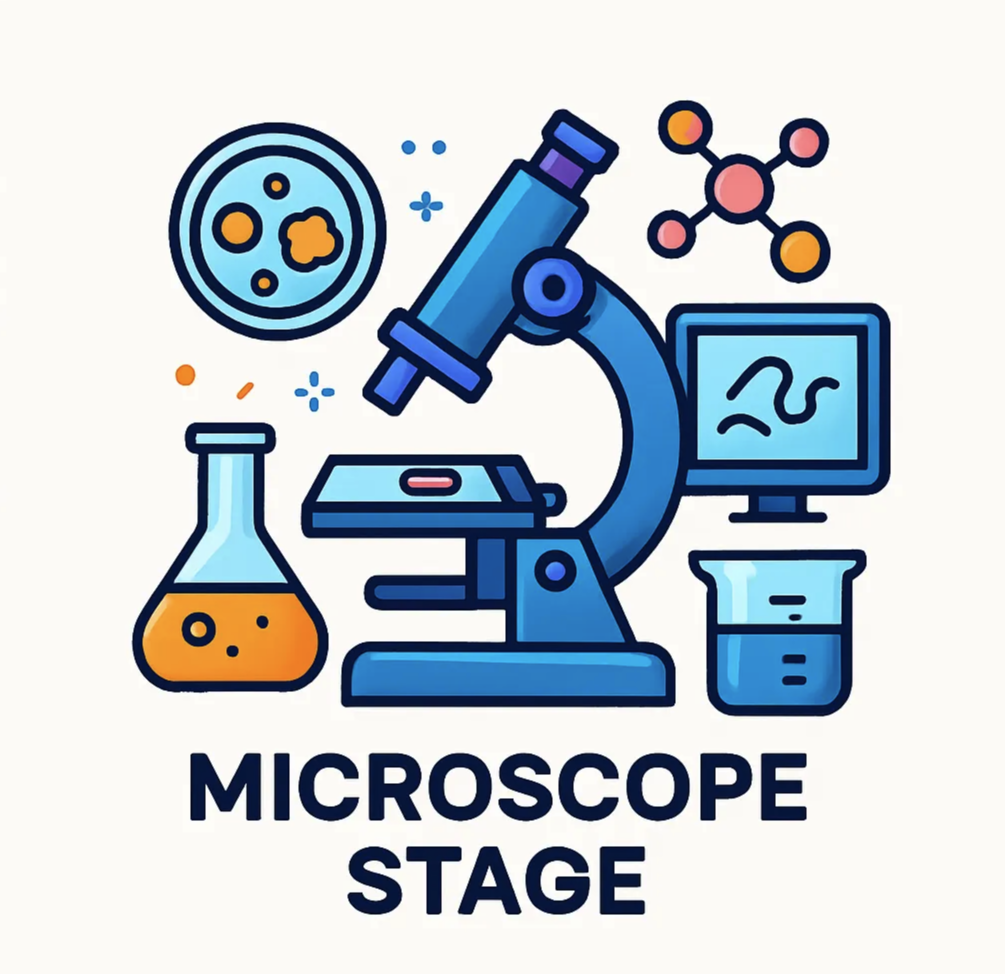
Finding an affordable microscope that delivers quality performance can feel overwhelming, especially for beginners and students. However, many options under $100 offer excellent features without compromising usability. For example, models like the AmScope M150C-MS provide wide-field eyepieces, adjustable LED lighting, and magnification up to 1000X, making them ideal for young learners.
Balancing cost, usability, and features is essential when choosing the best microscope under $100. Adjustable eyepieces and intuitive controls enhance ease of use, while considering future needs ensures long-term value. With the right choice, you can explore the microscopic world without exceeding your budget.
Key Considerations When Choosing a Microscope
Magnification Range
The magnification range of a microscope determines how much detail you can observe in a specimen. For beginners and students, this feature is crucial for effectively exploring the microscopic world. A range of 400x to 1000x is ideal for biological samples, allowing you to view cells, tissues, and even organelles. This range is beneficial for school projects and introductory biology lessons.
Microscopes under $100 typically offer the following magnification ranges:
-
Stereo Microscopes: 10x to 200x magnification, suitable for larger specimens like insects or rocks.
-
Pocket or Handheld Microscopes: 25x to 100x magnification, perfect for portability and quick observations.
-
Digital Microscopes: For example, the Carson Zorb Digital Microscope MM-940 offers 90x-480x magnification, making it both user-friendly and effective for detailed viewing.
Choosing the right magnification range ensures you can explore a variety of specimens while staying within your budget.
Build Quality and Durability
A sturdy microscope is essential for long-term use, especially for students who may handle it frequently. High-quality construction ensures stability during observations, even at higher magnifications. Many affordable models feature durable materials like metal frames, which resist wear and tear better than plastic alternatives.
Key features that enhance durability include:
-
Sturdy Build: Prevents wobbling and ensures clear images.
-
Protective Features: Built-in carry handles and dust covers extend the lifespan of your microscope.
-
Warranty: Many student microscopes come with lifetime warranties, offering peace of mind and long-term usability.
Investing in a durable microscope not only saves money but also ensures consistent performance over time.
Ease of Use
For beginners, ease of use can make or break the learning experience. A user-friendly microscope simplifies setup and operation, allowing you to focus on exploration rather than troubleshooting. Many beginner-friendly models feature design elements that minimize errors and enhance usability.
Common features that improve ease of use include:
-
Pre-focused Condensers: Simplify setup and reduce the learning curve.
-
Integrated Eyepieces: Minimize alignment errors and ensure consistent viewing.
-
LED Illumination: Provides adjustable, even lighting for clear observations.
-
Compact Design: Models like the Carson Zorb Digital Microscope MM-480 are praised for their portability and intuitive controls.
|
Feature |
Description |
|---|---|
|
Sturdy build |
Ensures stability, especially at high magnifications. |
|
LED illumination |
Offers bright, adjustable lighting for better visibility. |
|
Pre-focused condenser |
Reduces setup time and enhances ease of use. |
|
Compact design |
Makes the microscope portable and easy to store. |
Choosing a microscope with these features ensures a smooth and enjoyable experience, especially for young learners.
Additional Features
USB Connectivity
USB connectivity changes the way you interact with a microscope. It allows you to connect the device to a computer or tablet, enabling you to view, capture, and save images or videos of your specimens. This feature is particularly useful for students working on projects or presentations.
Many affordable microscopes, such as the Carson Zorb Digital Microscope MM-500, include this functionality.
With USB connectivity, you can share your findings with classmates or teachers effortlessly. It also provides an opportunity to analyze images on a larger screen, enhancing your ability to observe fine details. This feature ensures that even budget-friendly microscopes deliver modern functionality, making them versatile tools for learning and exploration.
LED Lighting
LED lighting plays a crucial role in improving the clarity of your observations. Unlike traditional light sources, LED lights offer consistent and adjustable brightness. This ensures that you can examine specimens under optimal lighting conditions, regardless of the environment.
Most microscopes under $100 come equipped with LED illumination. For example, the AmScope M150C-I features adjustable LED lighting, which enhances visibility and reduces eye strain during extended use.
LED lights are also energy-efficient and long-lasting, ensuring that your microscope remains functional for years without frequent replacements.
Accessories and Extras
Accessories and extras can significantly enhance your experience with a microscope. Many beginner-friendly models include useful additions such as prepared slides, cleaning kits, and carrying cases. These extras not only save you money but also provide everything you need to start exploring right away.
For instance, the Swift SW200DL often comes with a set of prepared slides, allowing you to dive into your observations immediately. Some models also include smartphone adapters, enabling you to capture images directly from the eyepiece.
These accessories improve the overall value and usability of your microscope, ensuring a seamless and enjoyable experience.
Top Picks for Best Microscopes Under $100
Swift SW200DL Compound Monocular Microscope
Key Features
The Swift SW200DL offers a range of features that make it one of the best microscopes under 100 options for beginners. Its specifications include:
|
Feature |
Description |
|---|---|
|
Magnification Settings |
Offers 40X, 100X, 250X, 400X, and 1000X magnification through various glass objectives. |
|
Dual Illumination |
Equipped with a dual illumination system for examining both transparent and solid specimens. |
|
Rugged Design |
Features a metal arm and base, carrying handle, and cordless capability for field use. |
|
User-Friendly |
Specifically designed for students, kids, adults, and hobbyists, making it ideal for beginners. |
|
Monocular Head |
Fully rotatable head for easy sharing and instruction in classroom settings. |
Pros and Cons
-
Pros:
-
Wide magnification range suitable for various specimens.
-
Durable design ensures long-term use.
-
Dual illumination enhances versatility.
-
Rotatable head simplifies group learning.
-
-
Cons:
-
Slightly heavier than other models, reducing portability.
-
Requires batteries for cordless operation.
-
Why It’s Great for Beginners and Students
This microscope for children and students combines durability with ease of use. The dual illumination system allows you to explore both biological and solid specimens, making it versatile for school projects. Reviews highlight its user-friendly design and effective magnification, ensuring a positive learning experience.
Carson Zorb Digital Microscope MM-500
Key Features
The Carson Zorb MM-500 stands out among inexpensive microscopes due to its unique features:
|
Feature |
Carson Zorb MM-500 |
Other Models Under $100 |
|---|---|---|
|
Flush View Adapter |
Yes |
No |
|
Depth View Adapter |
Yes |
No |
Pros and Cons
-
Pros:
-
Compact and lightweight design.
-
Built-in illumination ensures clear images.
-
USB connectivity allows easy sharing and analysis.
-
-
Cons:
-
Limited magnification range compared to compound microscopes.
-
Not ideal for advanced biological studies.
-
Why It’s Great for Beginners and Students
This digital microscope offers a modern approach to exploration. Its USB connectivity lets you capture and share images effortlessly. The built-in illumination enhances image quality, making it perfect for observing intricate details of everyday objects.
AmScope M150C-I Compound Microscope
Key Features
The AmScope M150C-I provides features tailored for students:
-
Three standard objective lenses: 4x, 10x, 40x.
-
Rotating head for easy viewing.
-
Fine focusing knobs on both sides.
-
LED lighting for bright and clear observations.
-
Two eyepieces: WF10X and 25X.
-
Dimmer for adjustable light control.
Pros and Cons
-
Pros:
-
High-quality construction ensures durability.
-
Wide magnification range supports detailed observations.
-
Compact design makes it easy to store.
-
-
Cons:
-
Requires a power source for LED lighting.
-
Limited accessories included in the base package.
-
Why It’s Great for Beginners and Students
This model offers excellent value for its price. The adjustable LED lighting and fine focusing knobs make it easy to use, even for younger learners. Its durable build ensures it can withstand frequent handling, making it a reliable choice for school or home use.
OMAX OM136C Student Compound Microscope
Key Features
The OMAX OM136C offers advanced features at an affordable price, making it a top contender for students. Its specifications include:
-
Magnification Range: Provides 40x to 1000x magnification, suitable for detailed biological studies.
-
All-Metal Frame: Ensures durability and stability during use.
-
LED Illumination: Adjustable lighting enhances visibility and reduces eye strain.
-
Dual Eyepieces: Includes WF10X and WF25X eyepieces for versatile viewing options.
-
Coarse and Fine Focus: Allows precise adjustments for clear and sharp images.
Pros and Cons
-
Pros:
-
Wide magnification range supports various applications.
-
Durable metal construction ensures long-term use.
-
LED lighting provides consistent illumination.
-
Fine focus knobs enhance image clarity.
-
-
Cons:
-
Heavier than other models, reducing portability.
-
Requires a power source for LED operation.
-
Why It’s Great for Beginners and Students
The OMAX OM136C combines durability, versatility, and precision, making it one of the best microscopes under 100 options for students. Its wide magnification range allows you to explore everything from cells to microorganisms. The sturdy build ensures stability, while the LED lighting and fine focus knobs make it easy to achieve clear observations. This model is ideal for school projects, hobbyists, and anyone seeking a high-quality microscope on a budget.
PalliPartners 100X-2000X High-Power Biological/Compound Microscope
Key Features
This PalliPartners Compound Microscope offers a versatile magnification range of 100X to 2000X, suitable for both adults and children. It boasts a professional-grade design with a WF25X eyepiece and 4X, 10X, and 40X objective lenses, providing six magnification levels for detailed biological studies. For clarity, it features a dual control focus system with coarse and fine focusing knobs, a reinforced metal frame for stability, and dual LED lights with brightness control and a 0.65 NA condenser for optimal illumination.
The kit is comprehensive, including 15 prepped slides, a phone adapter for capturing images and videos, and a carrying case. The microscope is also designed with portability in mind, weighing 3.2 lbs with a shockproof bag.
Pros and Cons
Pros:
- Wide Magnification Range: The 100X-2000X magnification is excellent for a broad spectrum of observations, from basic to more advanced.
- Comprehensive Kit: It comes with essential accessories like slides and a phone adapter, making it a ready-to-use package.
- Good Illumination: Dual LED lights with adjustable brightness and a condenser ensure good contrast for various specimen types.
- Sturdy Construction: The reinforced metal frame suggests durability for extended use.
- Budget-Friendly: The “Limited time deal” price makes it an accessible option.
- User-Friendly: Dual focus controls aid in achieving sharp images.
- STEM Focus: Marketed as a STEM learning tool, it encourages scientific exploration.
Cons:
- Monocular Design: While functional, a binocular design can offer greater comfort for extended viewing sessions.
- Potential Quality Variations: As with many products in this price range, the optical quality and build might not match high-end professional microscopes, though it aims for “lab-certified resolution.”
- Requires Batteries: The product details mention 1 “A” battery is required, which is not included in the main description and might be a minor inconvenience.
Why It’s Great for Beginners and Students
This PalliPartners microscope is an excellent choice for beginners and students due to its user-friendly design and comprehensive feature set. The dual focus system makes it easier to achieve clear images, which is crucial for developing observation skills. The included slide set and phone adapter allow students to start exploring immediately and to share their findings, fostering engagement and a deeper understanding of scientific concepts.
Its versatile magnification capabilities cater to a range of educational levels, from elementary school introductions to more involved high school biology projects. The durability and portability also make it suitable for both home use and school laboratory environments.
The competitive pricing and “Best Seller” status indicate its popularity and value for those starting their microscopy journey.
How to Choose the Right Microscope for You
Consider Your Age Group
Your age or the age of the intended user plays a significant role in selecting the right microscope. Younger users benefit from lightweight models made of durable materials like ABS plastic. These microscopes are easier to handle and less prone to damage. For older students, models with metal frames offer better stability and durability, making them suitable for advanced studies.
If you’re looking for a versatile option that works across age groups, consider models like the Superscope. It combines portability with functionality, making it ideal for elementary to high school students. Choosing a microscope tailored to the user’s age ensures a more enjoyable and productive experience.
Determine Your Intended Use
School Projects
For school projects, you’ll need a microscope that supports a variety of applications. Observing living cells, pond water samples, or plant structures can help you complete biology assignments effectively. Prepared slides of tissues, such as muscle or nerve samples, also provide valuable insights for classroom experiments.
Hobbies and Exploration
If you’re exploring as a hobby, look for a microscope that allows you to examine diverse specimens. You can observe crystal structures, microorganisms in food, or even everyday dust particles. Models with adjustable magnification and LED lighting are perfect for uncovering the hidden details of your surroundings.
Look for Additional Accessories
Accessories enhance the functionality and usability of your microscope. Slides and cover slips hold specimens securely, while staining kits improve visibility. Stage accessories allow precise movement, and cleaning supplies keep lenses in optimal condition.
|
Accessory |
Function |
|---|---|
|
Slides and cover slips |
Hold specimens and protect them, improving visibility. |
|
Enhance contrast and visibility of structures in specimens. |
|
|
Lighting accessories |
Provide illumination and enhance contrast for better observation. |
|
Carrying case |
Facilitates safe transport and storage of the microscope and accessories. |
When choosing a microscope, consider models that include these essential accessories. They save you money and ensure you have everything needed for a seamless learning experience.
Choosing the right microscope under $100 doesn’t have to be overwhelming. Affordable options like the Swift SW200DL and AmScope M150C-I offer excellent features, including durable builds, adjustable LED lighting, and versatile magnification ranges. These models ensure usability and long-term value, making them ideal for beginners and students.
Top Recommendations:
-
Best overall: Swift SW380T – A professional-grade option for students.
-
Best budget-friendly: AmScope M150C-MS – A reliable starter microscope.
-
Best for biology studies: AmScope B120C – Perfect for detailed biological observations.
-
Best portable option: Omano Discovery Professional – Lightweight and versatile.
To find the perfect fit, follow these steps:
-
Understand your research needs and the level of detail required.
-
Balance your budget and explore options within your price range.
-
Consider technical specifications like magnification, optics, and lighting.


